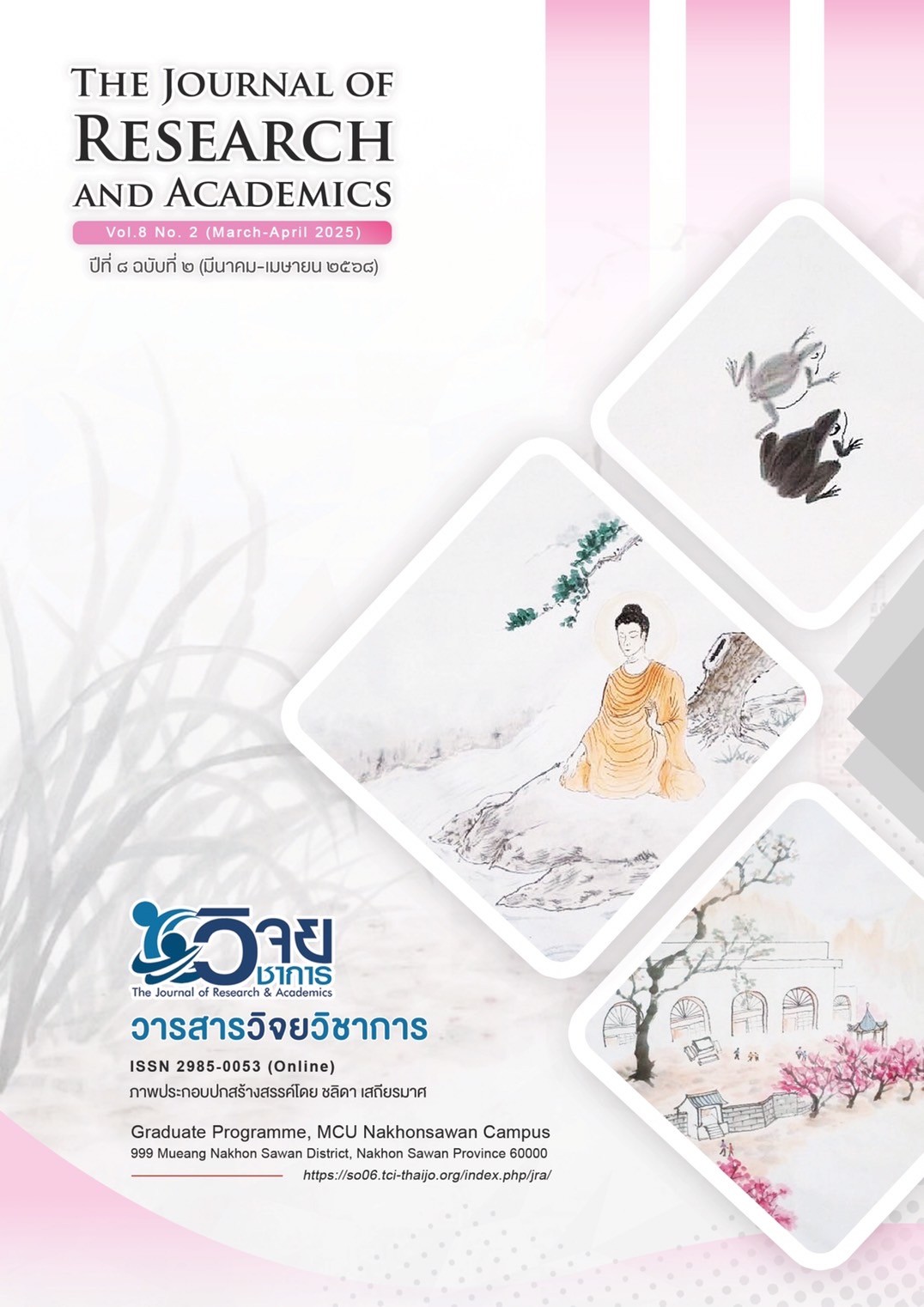A study of Components of a Flipped Classroom Model with Blended Learning to Promote Information Literacy of Undergraduate Students at the College of Dramatic Arts
Main Article Content
Abstract
The purposes of this research article were 1) to develop the flipped classroom model with blended learning; and 2) to evaluate the quality of the flipped classroom model with blended learning to promote information literacy of undergraduate students at the College of Dramatic Arts. The sample group consisted of 9 experts by purposive sampling. The research instruments were an opinion questionnaire, a model quality assessment form, and a model quality assurance assessment form. The statistics used for data analysis were mean and standard deviation. The research results found that 1) the components of the flipped classroom model with blended learning to promote information literacy of undergraduate students at the College of Dramatic Arts consisted of 9 main components and 38 subcomponents. The 7 main components of context were 1) instructional media component, 2) instructor component, 3) subject content component, 4) learner component, 5) information technology component, 6) teaching method component, and 7) evaluation component and 2 main process components were learning management steps and teaching and learning activities organization; 2) for the results of the quality search of the model, experts had opinions and assessed the appropriateness of the format, finding that overall the quality was at a high level ( = 4.43, S.D. = 0.20). When separated into each aspect, it was found that the component with the highest level of appropriateness was evaluation. The most appropriate components were teaching media (
= 4.51, S.D.=0.66) and teaching activities (
= 4.59, S.D.=0.76). The components with the most appropriate components were teaching media (
= 4.47, S.D.=0.67), teachers (
= 4.42, S.D.=0.77), course content (
= 4.42, S.D.=0.71), information technology (
= 4.45, S.D.=0.71), learners (
= 4.43, S.D.=0.69), learning management steps (
= 4.38, S.D.=0.71), and teaching methods (
= 4.37, S.D.=0.73), respectively. All components were consistent. Experts endorsed the quality of all components of the model.
Article Details

This work is licensed under a Creative Commons Attribution-NonCommercial-NoDerivatives 4.0 International License.
1. เนื้อหาและข้อมูลในบทความที่ลงพิมพ์กับวารสารวิจยวิชาการ ถือเป็นข้อคิดเห็น และความรับผิดชอบของผู้เขียนบทความโดยตรงซึ่งกองบรรณาธิการวารสารไม่จำเป็นต้องเห็นด้วย หรือร่วมรับผิดชอบใด ๆ
2. บทความ ข้อมูล เนื้อหา รูปภาพ ฯลฯ ที่ได้รับการตีพิมพ์ในวารสารวิจยวิชาการ ถือเป็นลิขสิทธิ์ของวารสารวิจยวิชาการ หากบุคคลหรือหน่วยงานใดต้องการนำทั้งหมดหรือส่วนหนึ่ง ส่วนใดไปเผยแพร่ต่อหรือเพื่อการกระทำการใด ๆ จะต้องได้รับอนุญาตเป็นลายลักษณ์อักษรจากวารสารวิจยวิชาการก่อนเท่านั้น
References
กอบชัย สิริพงศ์ดี. (2565). การพัฒนารูปแบบการเรียนรู้แบบผสมผสานด้วย อินเทอร์เน็ตแห่งสรรพสิ่งบนสมาร์ทโฟน สำหรับนักศึกษาบัณฑิตศึกษาของไทย. (วิทยานิพนธ์ครุศาสตรอุตสาหกรรมดุษฎีบัณฑิต สาขาวิชาครุศาสตร์อุตสาหกรรม สาขาวิชาเทคโนโลยีการศึกษา). คณะครุศาสตร์ อุตสาหกรรมและเทคโนโลยี : สถาบันเทคโนโลยีพระจอมเกล้าเจ้าคุณทหารลาดกระบัง.
จันทกานต์ พันเลียว. (2562). การพัฒนาทักษะการรู้สารสนเทศในรายวิชาโครงงานสารสนเทศศาสตร์ของนิสิต ระดับปริญญาตรี คณะวิทยาการสารสนเทศ มหาวิทยาลัยมหาสารคาม. (วิทยานิพนธ์ศิลปศาสตรมหาบัณฑิต สาขาวิชาสารสนเทศศาสตร์). บัณฑิตวิทยาลัย : มหาวิทยาลัยมหาสารคาม.
เฌอริสา นันทา. (2565). การพัฒนาทักษะการแก้ปัญหาด้วยรูปแบบการจัดการเรียนรู้ห้องเรียนกลับด้านร่วมกับปัญหาเป็นฐาน สำหรับนักศึกษาระดับปริญญาตรี. (วิทยานิพนธ์ปรัชญาดุษฎีบัณฑิต สาขาวิชาคอมพิวเตอร์ศึกษา). คณะครุศาสตร์อุตสาหกรรมและเทคโนโลยี : สถาบันเทคโนโลยีพระจอมเกล้าเจ้าคุณทหารลาดกระบัง.
ทิศนา แขมมณี. (2551). ศาสตร์การสอน: องค์ความรู้เพื่อการจัดกระบวนการเรียนรู้ที่มีประสิทธิภาพ. (พิมพ์ครั้งที่ 8). กรุงเทพฯ : สำนักพิมพ์แห่งจุฬาลงกรณ์มหาวิทยาลัย.
วรางคณา โตโพธิ์ไทย. (2565). การพัฒนารูปแบบการเรียนการสอนแบบผสมผสานโดยใช้สื่อสังคมสำหรับนักศึกษาระดับบัณฑิตศึกษา สาขาวิชาศึกษาศาสตร์ มหาวิทยาลัยสุโขทัยธรรมาธิราช. (รายงานการวิจัย). มหาวิทยาลัยสุโขทัยธรรมาธิราช : สำนักบรรณสารสนเทศ.
วิจารณ์ พานิช. (2555). วิถีสร้างการเรียนรู้เพื่อศิษย์ในศตวรรษที่ 21. กรุงเทพฯ : มูลนิธิสดศรีสฤษดิ์วงศ์.
วิจารณ์ พานิช. (2556). ครูเพื่อศิษย์สร้างห้องเรียนกลับด้าน. (พิมพ์ครั้งที่ 2). กรุงเทพฯ : เอส.อาร์.พริ้นท์ติ้ง แมสโปรดักส์.
วิทยาลัยนาฏศิลปสุโขทัย. (2562). หลักสูตรศึกษาศาสตรบัณฑิต. (หลักสูตรปรับปรุง พ.ศ.2562). สุโขทัย : วิทยาลัยนาฏศิลปสุโขทัย.
สำนักงานเลขาธิการสภาการศึกษา. (2560). แผนการศึกษาแห่งชาติ พ.ศ.2560-2579. กรุงเทพฯ : พริกหวานกราฟฟิค.
อัจฉรา เชยเชิงวิทย์. (2560). การพัฒนารูปแบบการจัดการเรียนการสอนแบบห้องเรียนกลับด้าน โดยใช้การเรียนรู้แบบร่วมมือผ่านเครือข่ายสังคม. วารสารเทคโนโลยีอุตสาหกรรม มหาวิทยาลัยราชภัฏอุบลราชธานี, 1(1), 163-178.
Brian, J. B. (2010). Hybrid Courses with Flexible Particpation-The Hyflex Design. Retrieved from https://www.igi-global.com/gateway/chapter/92972# pnl RecommendationForm
Santos, M. V. & Mayoral, R. M. (2018). Information literacy in managers’ education. Journal of Business & Finance Librarianship, 23(2), 167-182.

